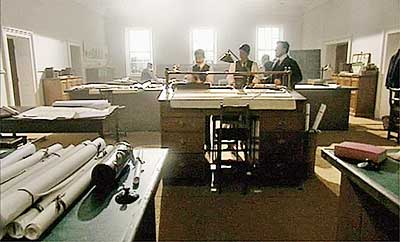THE TITANIC
The story of the Titanic is now legendary. In an era of confidence and unfettered optimism, the liner was designed to be two and a half times the size of its nearest rival and to set new standards in technological achievement and luxurious accommodation.
 The idea to build a fleet of three gigantic, opulently luxurious ocean liners was dreamt up over a post dinner drink. The owner of the White Star shipping line, Joseph Bruce Ismay, needed some spectacular ships to compete with his arch-rivals, the shipping line Cunard, which had just launched the hugely successful Lusitania and Mauretania.
The idea to build a fleet of three gigantic, opulently luxurious ocean liners was dreamt up over a post dinner drink. The owner of the White Star shipping line, Joseph Bruce Ismay, needed some spectacular ships to compete with his arch-rivals, the shipping line Cunard, which had just launched the hugely successful Lusitania and Mauretania.
To rebuild just the Titanic today would probably cost at least £210 million.
Bruce Ismay and his wife went to dinner with Lord William Pirrie, the boss of the great ship building company Harland & Wolff. After dinner, when the women retired and Bruce Ismay and Lord Pirrie relaxed over a port, Bruce Ismay revealed his idea. He would commission Harland & Wolff to build two incredible liners of hitherto unheard of size and luxury with a third to follow in the wake of their success.
That April evening in 1907 at Lord Pirrie’s London home, Devonshire House in Belgrave Square, the two men discussed the construction of the two Olympic-class liners they would build. They would enable White Star to compete for the lucrative business of the transatlantic run by being much bigger, far heavier and a great deal more luxurious than any liner that had gone before them. Their names were to be Olympic, Titanic and Gigantic (later renamed Britannic).
THE PREPARATION
Before the Olympic and Titanic could be built Lord Pirrie had to rebuild his shipyard. The engineers who had built the famous Fourth Bridge in Scotland were brought in to build a huge new gantry that could accommodate the two largest ocean liners ever built at that time – Olympic and Titanic – side by side. It weighed over 6,000 tons
(5,400 tonnes) and cost £100,000. It was taller than Westminster Abbey and supported a complicated system of cranes designed to reach every part of the ship.
Harland & Wolff also purchased a 200-ton (180 tonnes) floating crane from Germany at a cost of £30,000 to lower the ships’ massive engines into place. And Belfast taxpayers bore the cost of razing three existing slipways to the ground to extend the berthing piers by 100 feet.


